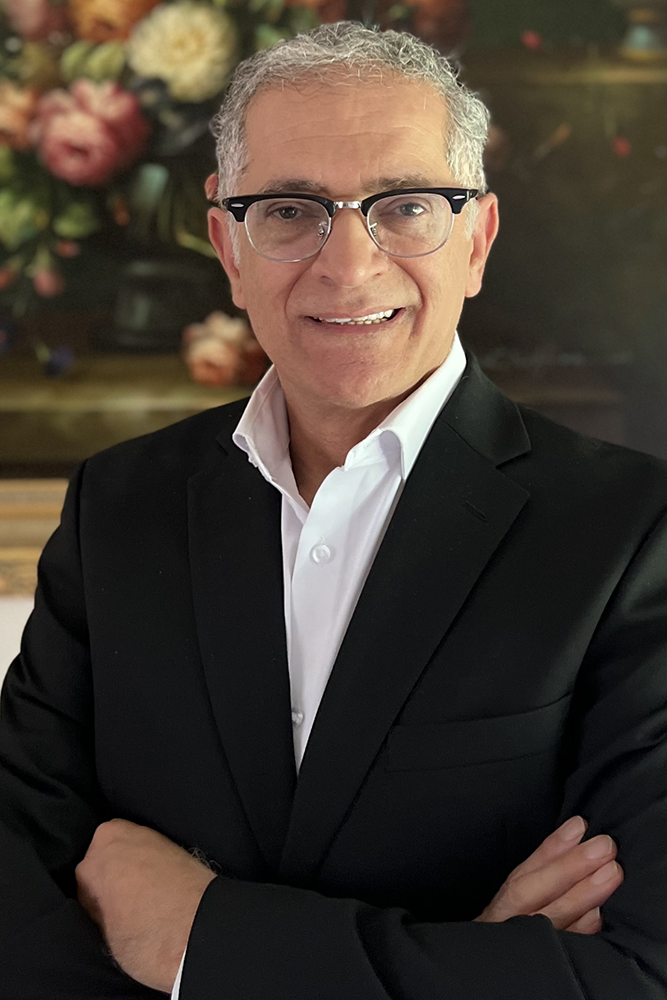Kamal Sarabandi honored with 2024 IEEE Electromagnetics Award

Kamal Sarabandi, the Rufus S. Teesdale Professor of Engineering and Fawwaz T. Ulaby Distinguished University Professor of Electrical Engineering and Computer Science, has been selected to receive the 2024 IEEE Electromagnetics Award “for contributions to electromagnetic sensing technology and metamaterials for antenna miniaturization.”
Sarabandi is an internationally-renowned researcher in the areas of applied electromagnetics and remote sensing. His areas of specialty include microwave and millimeter-wave radar remote sensing, antennas, metamaterials, wireless systems, and millimeter-wave and submillimeter-wave subsystems and components with applications to radar imaging (collision avoidance, autonomous vehicle control, security, and more).
Over the past 20 years, Sarabandi and his students have made substantial contributions to the advancement of antenna technology by developing highly efficient miniaturized antennas for a wide range of wireless and radar applications. He has been a pioneer in the development of antennas for miniature mobile platforms and in the merging of acoustics and electromagnetics for subsurface sensing and imaging for use in biomedical imaging, as well as underground target detection.
He contributed to the Shuttle Imaging Radar that flew on NASA’s Shuttle Imaging Radar-C (SIR-C) mission in 1994, the most advanced radar system to ever fly in space at the time. Later he was involved in the Shuttle Radar Topography Mission (SRTM), which provided data to generate the first nearly global, high-accuracy topographical map of the Earth. The shuttle was launched aboard the Space Shuttle Endeavor on Feb. 11, 2000. The calibration techniques he used to validate the map are now the standard approach used worldwide.
In addition, Sarabandi and his team constructed the most powerful radar calibration device in the world to interface with NASA’s newest orbiting satellite, called Soil Moisture Active Passive (SMAP), which launched Jan. 31, 2015. SMAP’s mission is to map worldwide surface soil moisture to enhance our understanding of weather and climate, while improving our ability to predict weather patterns. He received the NASA Group Achievement Award for his contributions to SMAP.
Sarabandi currently serves as Co-Director of the Center of Excellence for Microwave Sensor Technology, which is focused on designing the next generation of automotive radar. Additional research happening in the Center includes subsurface imaging of buried objects; compact and low-power THz integrated circuits for hidden object detection in airports as well as detection of cracks in industrial settings; and wireless power transfer.
Sarabandi served as Director of the University of Michigan’s Radiation Laboratory (RADLAB) between 2000-2021. Under his leadership, the RADLAB grew to become one of the most recognized applied electromagnetic groups in academia worldwide. He also served as Director of the Center for Objective Microelectronics and Biomimetic Advanced Technology (COMBAT) between 2008-2018, funded by the Army Research Lab’s Micro-Autonomous Systems and Technology (MAST) program.
Over its 10-year history, COMBAT developed next-generation technologies for sensing, information processing, navigation, control, and communication, all focused on miniature-size ground and airborne robots. It led to several groundbreaking projects, including Sarabandi and his team’s development of the world’s smallest and most advanced radar that can be used on miniaturized airborne platforms to image objects behind walls, as well as provide for collision avoidance and mapping the interiors of buildings.
Sarabandi has supervised 63 PhD and numerous masters and post-doctoral students in a wide range of topics including radar remote sensing, acousto-electromagnetic sensing, sub-surface and through-the-wall sensing, wave propagation, antennas, metamaterials, millimeter-wave and sub-millimeter wave radars and systems.
Sarabandi is co-founder and principal of three high tech companies in Michigan: EMAG Technoliogies, Opteos Inc., and Gradient Technologies LLC.
- EMAG Tech.was launched in 1994 and has been engaged in the development of advanced computational electromagnetic software tools as well as microwave and MMW communication, radar, and tracking systems
- Opteos Inc. was lauched in 2004 and has been developing electro-optical systems sepcifically for non-intrusive and high resolution EM field mapping and measurements for a wide range of applications
- Gradient LLC was an automotive antenna company that was acquired in 2001
Sarabandi recently launched Navisense, LLC to commercialize a new generation of imaging radars at 240 GHz radars for driverless vehicles. Commercial products of these companies have been widely used by automotive, defense,and biomedical industies as well as many government laboratories.
Sarabandi’s leadership activities also include two terms on the NASA Advisory Council (advisory to the NASA Administrator), President of the IEEE Geoscience and Remote Sensing Society, and Chair of Commission F, United States National Committee for The International Union of Radio Science (USNC/URSI).
He is a Member of the National Academy of Engineering and a Fellow of the National Academy of Inventors, the American Association for the Advancement of Science (AAAS), and IEEE. He has received the IEEE Judith A. Resnik Field Award, IEEE Geoscience and Remote Sensing Society Distinguished Achievement Award, and IEEE Geoscience and Remote Sensing Society Education Award. He was named Rufus S. Teesdale Endowed Professor of Engineering in 2008.
About the award
The IEEE Electromagnetics Award was established by the IEEE Board of Directors in 1996 and is sponsored by the IEEE Antennas and Propagation Society, the IEEE Electromagnetic Compatibility Society, the IEEE Microwave Theory and Techniques Society, and the IEEE Geoscience and Remote Sensing Society. Only one recipient is chosen among the top researchers across all four IEEE societies.
U-M ECE professors who have received this award in the past are:
- Fawwaz Ulaby, Emmett Leith Distinguished University Professor Emeritus of Electrical Engineering and Computer Science; Arthur F. Thurnau Professor Emeritus
- Professor Leung Tsang
- Professor Emeritus Thomas B. A. Senior